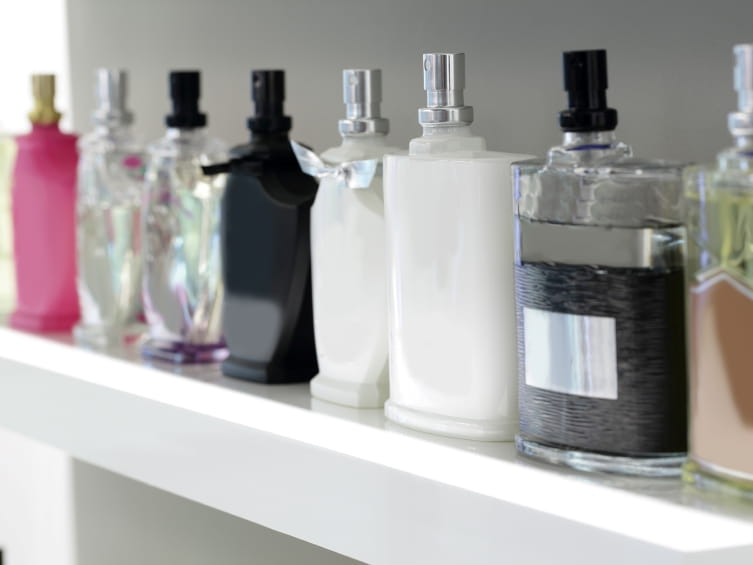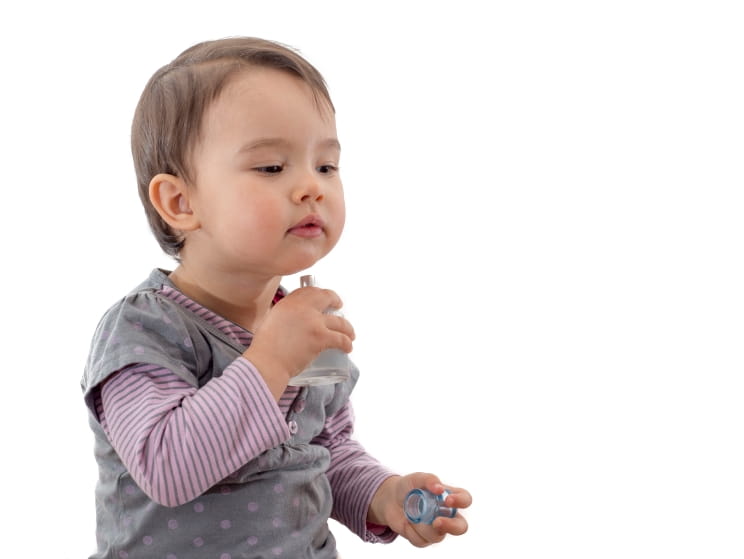My Child Drank Perfume: Prevention and Treatment Tips

The Bottom Line
Most fragrance products contain alcohol, which can cause serious effects in children. Fragrance products can also cause skin irritation and allergic reactions, which will usually go away if you stop using the product.

What are the major ingredients of perfume?
Fragrance products provide a pleasant smell when applied to the body. These products have 2 main components: a fragrance (usually an oil, often derived from flowers) and an alcohol (usually ethanol) and water mixture. Once the fragrance is on the skin, the alcohol and water evaporate, leaving the pleasant-smelling oil behind. Products with higher concentrations of fragrance last longer, require a higher concentration of alcohol, come in smaller bottles, and are more expensive.
The table below shows 3 characteristics of fragrance categories: the proportion of the product that is the fragrant substance, the alcohol component of the alcohol-water mixture, and how long the scent will last after application. The product categories are in French to be consistent with common product labeling.
|
Product |
Typical % fragrance |
Typical % alcohol |
Typical duration |
|
Parfum |
20–40 |
98 |
Up to 24 hr |
|
Eau de parfum |
15–20 |
90 |
4–5 hr |
|
Eau de toilette |
5–15 |
80 |
2–4 hr |
|
Eau de cologne |
2–5 |
60 |
Up to 2 hr |
Symptoms of perfume poisoning
Fragrance products are very attractive to children because of their smell and their ornate bottles. The most important risk presented by fragrance products is alcohol poisoning. In children, alcohol causes drowsiness and inebriation just like in adults, but it also can drop their blood sugar to dangerously low concentrations. The brain needs sustained levels of sugar to function normally. Children can develop slurred speech, show depressed breathing, loss of coordination, pass out, or even have seizures.
Can perfume cause an allergic reaction?
Perfumes and colognes can cause skin irritation. Furthermore, there are at least 175 fragrance ingredients that can cause allergic reactions. According to the American Academy of Dermatology, fragrance products are the leading cause of cosmetic-related contact dermatitis.
If a skin reaction occurs, wash the skin with soap and water to remove any remaining product and discontinue use of the product. If inflammation or irritation persists, an over-the-counter topical steroid like 1% hydrocortisone can be applied.
What to do if your child drinks perfume or cologne
If your child drinks perfume, cologne, or any source of alcohol, give them a light snack to prevent their blood sugar from dropping. Get guidance from Poison Control immediately to determine if your child has swallowed a dangerous amount: call 1-800-222-1222 or use thewebPOISONCONTROL tool for online help.
Additionally, Contact Poison Control if you think it’s possible that your child might have gotten into a perfume or cologne. Smell near the child's mouth if you think some was swallowed. If a fragrance product was inadvertently sprayed into the eyes, rinse gently for 15 min with lukewarm water and then call or get online help from Poison Control.
Pela Soto, PharmD, BSHS, BS
Certified Specialist in Poison Information
Revised William G. Troutman, PharmD
Professor of Pharmacy Emeritus
Poison Control Media Information
Did you find this page helpful? If so, we need your support. Poison Control is in constant competition with misinformation online. Links to www.poison.org or our webPOISONCONTROL triage tool from other websites and blogs help internet searchers quickly find accurate information and Poison Control’s contact information in an emergency. If you use the content from this page, please provide attribution via a link back to this page, www.poison.org, or https://triage.webpoisoncontrol.org/#!/exclusions. By doing so, you could save a life. Thank you!
Poisoned?
Call 1-800-222-1222 or
Prevention Tips
- Keep all fragrance products out of reach of children.
- Do not apply fragrance products in the presence of young children.
- If you apply a fragrance product to a child, make sure the child knows never to apply it on their own.
This Really Happened
A mother called Poison Control because her 2-year-old daughter licked a rollerball perfume product about 20 minutes earlier. The girl was sleepy, but the mother was not sure if it was because the girl was up late the previous night. The mother was unsure what the percentage of alcohol was in the perfume. Poison Control was able to find the product’s alcohol concentration and then calculate how much alcohol the girl might have swallowed. Fortunately, the amount of alcohol swallowed was very small, so Poison Control advised the mother to let her daughter sleep but to call back if there were any changes or concerns. Poison Control followed up the next day, and the girl was acting normally.
For More Information
Alcohol poisoning. Mayo Clinic. April 29, 2023. Accessed October 21, 2024.
Soloway RAG. alcohol: a dangerous poison for children. The Poison Post. February 2013.
References
Perfume and concentration. Sylvaine Delacourte. Accessed October 21, 2024.
Yip L. Ethanol. In: Nelson LS, Howland MA, Lewin NA, Smith SW, Goldfrank LR, Hoffman RS, eds. Goldfrank’s Toxicologic Emergencies. 11th ed. New York: McGraw-Hill Education; 2015.
Poisoned?
Call 1-800-222-1222 or
Prevention Tips
- Keep all fragrance products out of reach of children.
- Do not apply fragrance products in the presence of young children.
- If you apply a fragrance product to a child, make sure the child knows never to apply it on their own.
This Really Happened
A mother called Poison Control because her 2-year-old daughter licked a rollerball perfume product about 20 minutes earlier. The girl was sleepy, but the mother was not sure if it was because the girl was up late the previous night. The mother was unsure what the percentage of alcohol was in the perfume. Poison Control was able to find the product’s alcohol concentration and then calculate how much alcohol the girl might have swallowed. Fortunately, the amount of alcohol swallowed was very small, so Poison Control advised the mother to let her daughter sleep but to call back if there were any changes or concerns. Poison Control followed up the next day, and the girl was acting normally.
